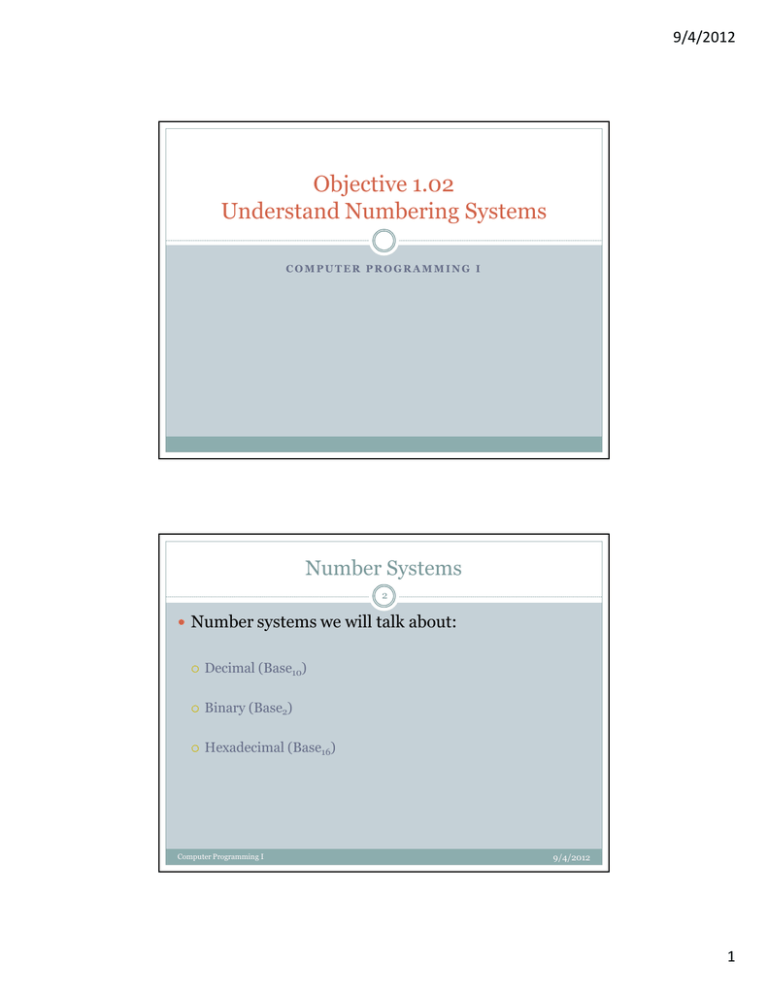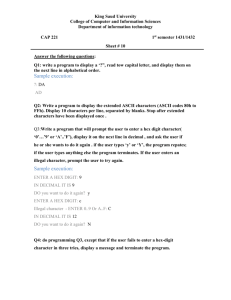Objective 1.02 Understand Numbering Systems
advertisement

9/4/2012 Objective 1.02 Understand Numbering Systems COMPUTER PROGRAMMING I Number Systems 2 Number systems we will talk about: Decimal (Base10) Binary (Base2) Hexadecimal (Base16) Computer Programming I 9/4/2012 1 9/4/2012 Decimal 3 The number system we use in math and in life. Base 10: ten one digit numbers: 0,1,2,3,4,5,6,7,8,9 After 9 comes 10 (the first two digit number) of course. 102= 100 Base 1 2 3 6 7 8 0 9 4 5 squared = 100 Computer Programming I 9/4/2012 Decimal 4 What can we say about the decimal system? It is our day to day number system… The Decimal system has 10 digits; values are from 0 to 9. 0 10 1 11 2 12 3 13 4 14 5 15 6 16 7 17 8 18 9 19 20 21 22 23 24 25 26 27 28 29 30 40 50 60 70 80 90 100 31 41 51 61 71 81 91 101 32 42 52 62 72 82 92 102 33 43 53 63 73 83 93 103 34 44 54 64 74 84 94 104 35 45 55 65 75 85 95 105 36 46 56 66 76 86 96 106 37 47 57 67 77 87 97 107 38 48 58 68 78 88 98 108 39 49 59 69 79 89 99 109 2 9/4/2012 Binary 5 Binary is Base 2 2 one digit numbers 0 and 1 For example: Base 10 of 4 = Binary 0100 or 100 102=100 – works in binary too! 2 squared = 4 Computer Programming I 9/4/2012 Machine Language 6 Binary or Base2: Only contains 2 types of digits; 1 or 0. The power of 2. Each digit from the right to the left is increased by power of 2. Each one (1) digit has a value representing on and each zero (0) digit do not hold a value representing off. OOOO OOOO 128 64 32 16 8 4 2 1 Ex: 0000 1001= The right most digit (1) = 1 (20) The two middle digits are 0 therefore have no value. The left most digit (1) = 8 (23 or 2x2x2). The other digits have no value. The total value of all numbers would = 9. (8+0+0+1) ex: 0000 1111 8+4+2+1 = 15 in decimal amount 1111 1111 128+64+32+16+8+4+2+1 = 255 3 9/4/2012 Why Binary? 7 Computers operate on a series on electric impulses. If the current is flowing the circuit is complete (1), otherwise the current is off (0) Write down the powers of 2 from 0-128. 27 26 128 64 25 32 24 16 23 8 22 4 21 2 20 1 Computer Programming I 9/4/2012 Powers of 2 8 Remember from math the powers of 2: 1, 2, 4, 8, 16, 32, 64, 128 (first 8) Remember any number to the zero power is 1 and any number to the 1 power is that number. So if Decimal 4= 100 in binary, what does decimal 5 equal in binary? Computer Programming I 9/4/2012 4 9/4/2012 Powers of 2 9 Remember from math the powers of 2: 1, 2, 4, 8, 16, 32, 64, 128 (first 8) Remember any number to the zero power is 1 and any number of the 1 power is that number. So if Decimal 4= 100 in binary, what does decimal 5 equal in binary? A: 101 1 0 1 22 4 21 2 20 1 Computer Programming I 9/4/2012 The 1’s 10 So let’s go beyond our basic example. Remember the most right digit has the least significant value and the most left digit has the most significant value. What is 1111 1111 in Decimal? That would be 255. So… 1 0000 0000 would be 256, right? 1 1 27 26 128 64 Computer Programming I 1 1 1 1 1 1 25 32 24 16 23 8 22 4 21 2 20 1 1 0 0 0 0 0 0 0 0 28 27 26 25 24 23 22 21 256 128 64 32 16 8 4 2 20 1 9/4/2012 5 9/4/2012 Let’s Try This… 11 On your paper draw 8 columns Above each column label a power of 2, starting at 128 in the first (left most) column. Finish with 1 in the last (right most) column. 27 26 128 64 25 32 24 16 23 8 22 4 21 2 20 1 Computer Programming I 9/4/2012 Example Binary 12 Figure out the following numbers in binary… Decimal 56 100 198 64 18 84 231 Computer Programming I 27 26 128 64 25 32 24 16 23 8 22 4 21 2 20 1 9/4/2012 6 9/4/2012 Example Binary Answers 13 Figure out the following numbers in binary: Dec Binary (Answer) 56 111000 100 1100100 198 1100110 64 1000000 18 10010 84 1010100 231 11100111 Computer Programming I 9/4/2012 Hexadecimal 14 Hex is Base 16 There are fifteen one digit numbers: 0,1,2,3,4,5,6,7,8,9,A,B,C,D,E,F What comes after F? Remember our rule: 102=100 (162=256 in decimal) This works in Hex as it does for ANY number system. Computer Programming I 9/4/2012 7 9/4/2012 Hexadecimal 15 Contains 16 digits starting with 0-9 & A-F containing the values from 0 – 15. Hex Dec Hex Dec -Hex 20-2F and so on… 0 = 0 10 = 16 -Each digit carries a value of 16. 1 = 1 11 = 17 -Hex = 6 + Decimal = 10 (Hexadecimal =16) 2 = 2 12 = 18 -Hexadecimal is only 4 bits (binary value) 3 = 3 13 = 19 -ex: 1111 = 15 in decimal “F” in Hex value 4 = 4 14 = 20 -Another ex: 1001 1100 = 9C in Hex and 5 = 5 15 = 21 -156 in Decimal value. 6 = 6 16 = 22 7 = 7 17 = 23 8 = 8 18 = 24 9 = 9 19 = 25 Remember! Hex is only 4 bits long and its A = 10 1A = 26 highest value is F in Hex or B = 11 1B = 27 15 in decimal or 1111 in binary. C = 12 1C = 28 D = 13 1D = 29 Mainframe computers use Hexadecimal to E = 14 1E = 30 utilize less disk space. F = 15 1F = 31 Hexadecimal Conversion 16 Hex 9F to binary 9 F 1 0 0 1 1 1 1 23 8 22 4 21 2 20 1 23 8 22 4 Hex 9F to Decimal 9 F 161 16 160 16 21 2 1 20 1 9F Base 16 = 1001 1111 Base 2 9F Base 16 = 159 Base 10 (16 * 9) + (1 * 15) = 159 in Decimal Add the values… Computer Programming I 8 9/4/2012 Hexadecimal 17 Think if you had 3 hands. You would have 15 fingers right? That is what hex has! So after 9 comes A (10), B (11), C (12), D (13), E (14) and F (15) Let try our example again in Hex. Computer Programming I 9/4/2012 Another Conversion to Hexadecimal 18 Figure out the following Decimal numbers to Hex: Decimal 56 100 198 64 18 128 231 Computer Programming I 3 162 256 161 16 8 160 1 1. Ask “How many of ‘256’ can come out of 56 (our decimal number)? 0 2. Ask “How many of ‘16’ can come out of 56? 3 (3 * 16 = 48 with 8 left over) Put the 3 in the 16’s spot 3. Ask “How many of ‘1’ can come out of 8 (the left over)? 8 with 0 left over 9/4/2012 9 9/4/2012 Example Hex Answers 19 Figure out the following Decimal numbers to Hex: Dec Hex 56 38 100 64 198 C6 64 40 18 12 128 80 256 100 Computer Programming I 9/4/2012 Conclusion 20 In this lesson we learned about number systems used in Programming. Decimal Binary Hexadecimal Computer Programming I 9/4/2012 10 9/4/2012 For More Information 24 http://software2i.com/viewthread.php?tid=56509&e xtra=page%253D1&page=1 http://www.tpub.com/neets/book13/53e.htm http://www.plcs.net/chapters/number23.htm 11

